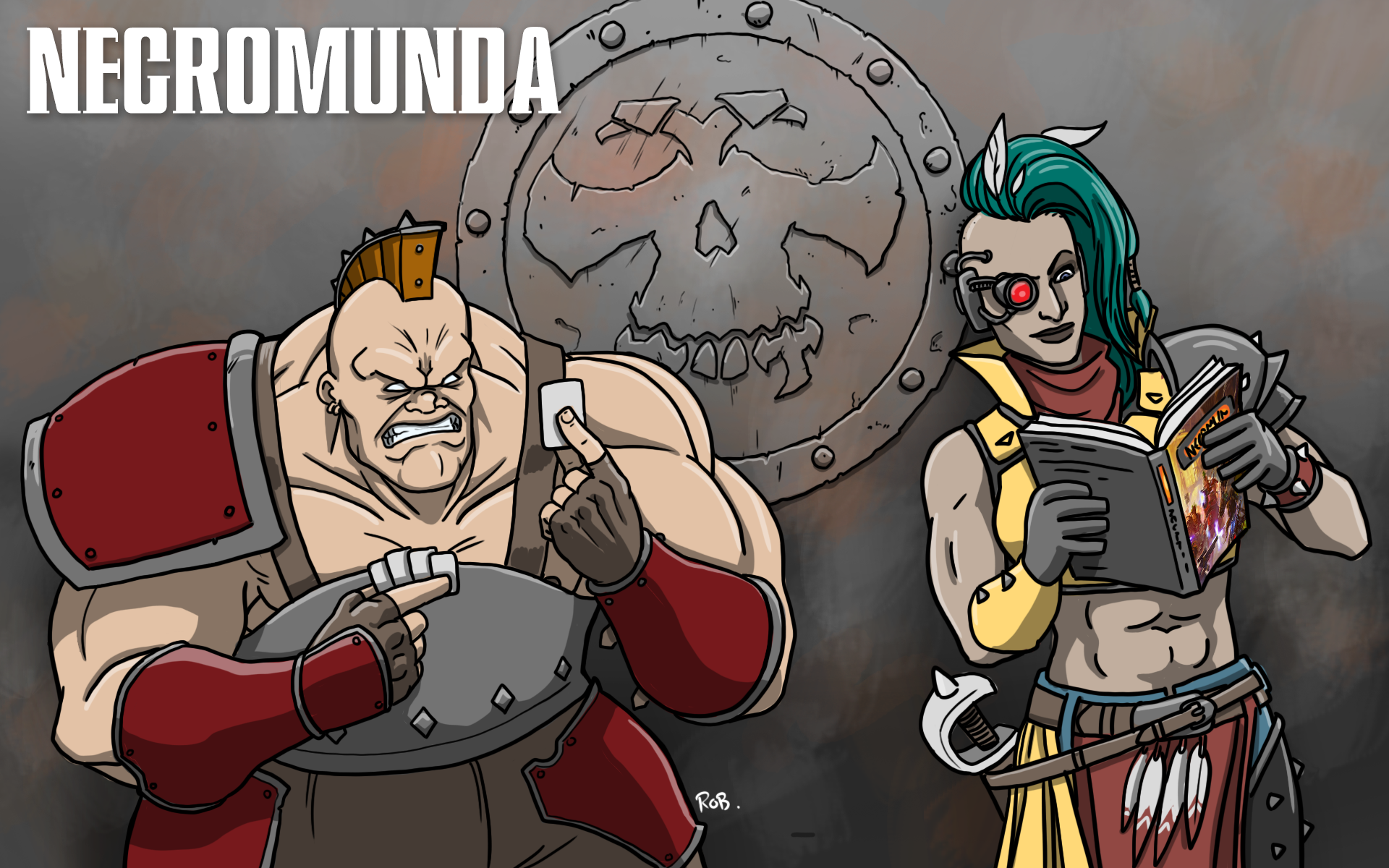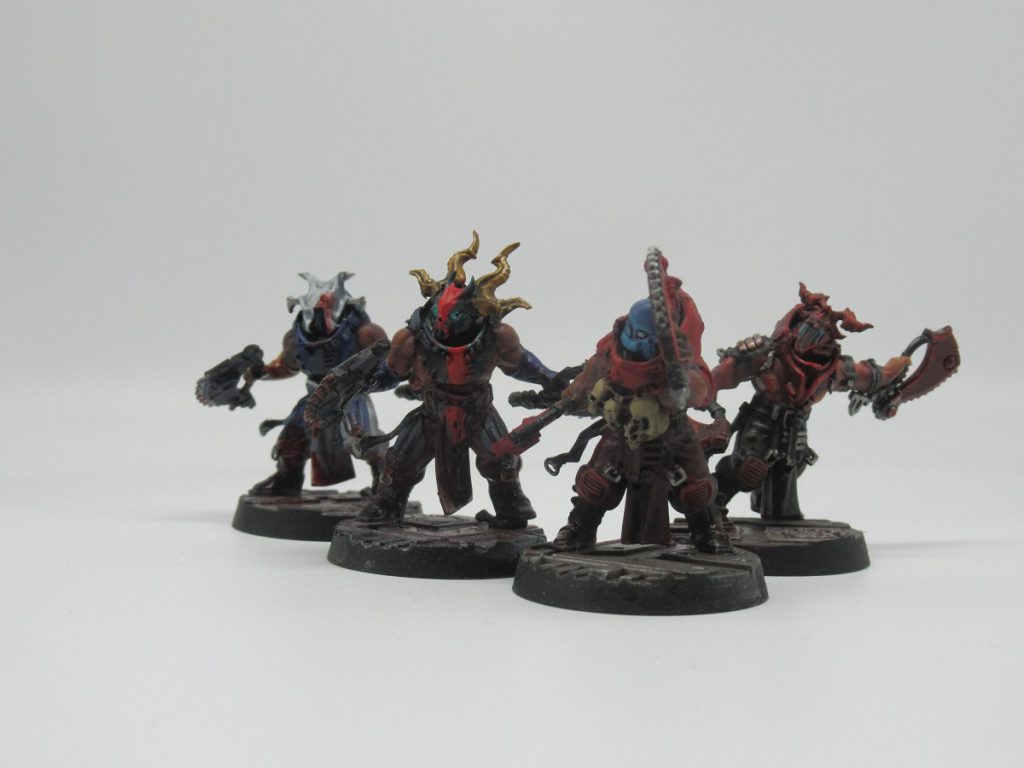We’re back, Scummers! Now that all the House books have dropped, the Underhive is a very different place compared to when Gangs of the Underhive was first released. The game has never been very well balanced, but with all this new stuff about, there are an ever-increasing number of rules which can bring a sense of unfairness to your campaigns. That’s very on-brand for life in the dystopian future, but it may interfere with your group’s fun. Today we’re going to talk about what particular things in the game might strike your group as ‘unfair’ and what to do about it.
Necromunda is a campaign game and any gang taking part in a campaign has a hell of a lot of different options to spend credits on after each game. To a certain extent, that’s the game’s balancing mechanism. Unless one gang picks nothing but top-tier, efficient weapons and the best equipment, and their opponents pick a medley of random trash, everything generally works. Most people will build their gangs’ rules to their models and aesthetic taste (the ‘Rule of Cool’) and with player skill and a hefty dose of Necromunda random outcomes thrown in, things balance out. But we have all heard of campaigns which devolve into an arms race of equipment combos, heavy weapons and stacking armour saves. This article is aimed at Arbitrators and players who are concerned about balance issues disrupting their campaigns.
Throughout this article, I will refer to certain things as “imbalances” – options which are very strong in most situations. Others are “mismatches” – when two gangs come up against each other, their rules and equipment may interact in way that favours one or the other disproportionately.
Are you House-Ruling as Needed, or at the Start?
There are two types of Arbitrators. Some want to put extensive house rules in place at the start of the campaign, make everything clear and try to fix the balance issues of the game. Some will only step in as needed, if a player does start to have a negative experience or start to ruin others’ fun. The latter approach saves effort, because there’s a lot of Necromunda rules to re-balance, you want your entire group to buy in and agree with house rules, and it can be a laborious process. Some groups enjoy trying to ‘fix the game’ and some have a strong bias towards playing out of the book without changes. I think this is a very important conversation for the Arbitrator to have with their group before a campaign. As well as understanding what gangs everyone wants to play (which will determine what imbalances and mismatches you need to worry about) you can see what experience everyone wants out of the campaign. Does anyone want to maximise the efficiency of their gang, and damn all other considerations? If one or all of your players have that approach, you may want to start putting some stops in place.
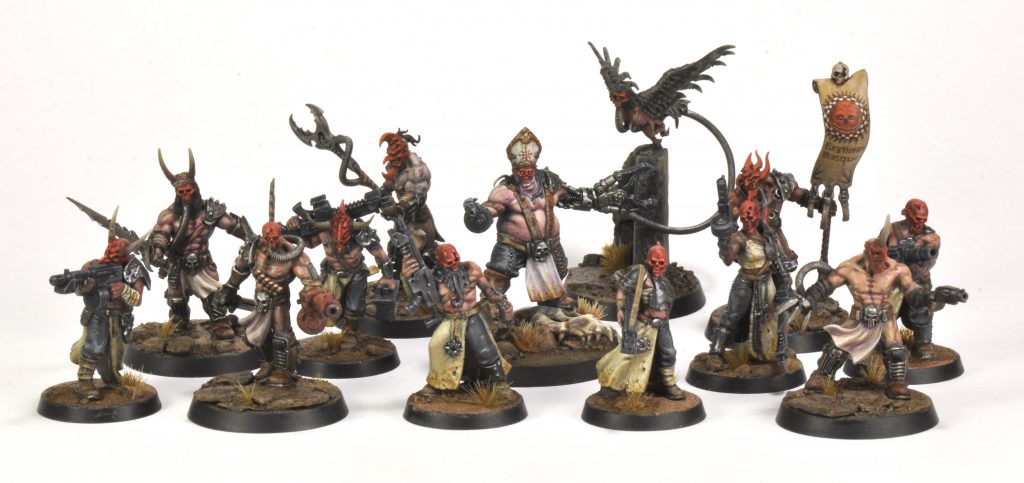
Are Certain Gangs Advantaged/Disadvantaged?
Do you need to worry on a basic level that some players will be at a disadvantage just by virtue of their starting gang type? This is a common question I see asked online by new players. With the ‘House of’ books now complete for the classic six Houses of Necromunda, they all get some unique rules (as well as House equipment lists). In roughly descending power order: Goliaths can do obscene things with Gene-Smithing and Cawdor Acts of Faith (and extra fighters in starting Crews) are very strong and flexible; Orlocks get neat cost-free bonus minor skills and Delaque have Psychic options which can provide a good alternative to normal shooting/fighting; Van Saar have Cyberteknika options which can open up some builds and mitigate injuries and Escher get Chem-Alchemy which is expensive for what it does but can boost some of their signature Toxin and Gas weapons. That’s not a ranking of the gangs in general – that’s a much longer discussion for another article – just how the power of their unique rules shake out. As with any aspect of the game, it’s your most competitive-minded players who will maximise these special rules, and Goliath and Cawdor are the only ones I would consider intervening on:
- If one of your stronger players is a Goliaths player, we would advise checking their approach to Gene-Forging. The ability to give all your gang +1 Toughness for +10 credits each is very powerful. It’s a very good deal, when sought-after +1T Advances in the campaign raise Gang Rating by +30 credits. T5 can really shock players who haven’t thought about it and planned ahead, so maybe check a Goliath list before the start of a campaign. We’re not advising disallowing Gene-Forging or anything; just consider if the competing players are going to be oppressed by it. If your group doesn’t want to go full cut-throat, a Goliath player could be asked to use it in what seems to be the intended way, individualising certain fighters and creating unique character, instead of treating the upgrades as a system to maximise effectiveness.
- Cawdor Acts of Faith are more dynamic, so they really don’t need to be curtailed at the outset of a campaign. I would just keep an eye out if one of your savvier players is using them to dominate games (alongside Cawdor’s other strengths). If a certain Act of Faith is being spammed constantly, or when the Cawdor player faces a certain gang, one Act of Faith is the obvious choice and frustrates their opponents favourite moves, consider stepping in if that is creating negative play experiences. To some extent, it’s part of the game, the enemies of the righteous shouldn’t love the effects, but keep an eye on how they feel about it.
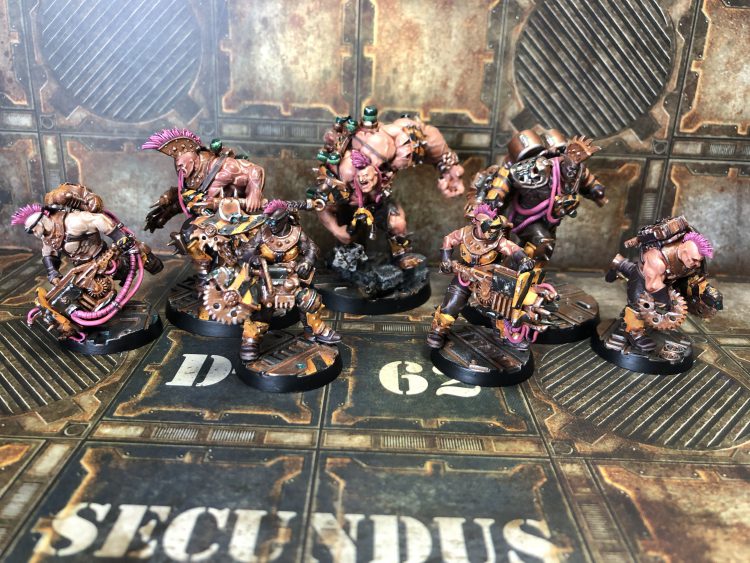
On the other end of the spectrum Enforcers, Venators, Genestealer Cults, Helot Cults, Corpse Grinder Cults & Slave Ogryn Gangs are all left to stand on their own equipment lists. While this seems unfair on the face of it, all of these non-House gangs have some strengths to leverage: Corpse Grinders especially are notoriously strong; Ogryns S5/T5 stats can have a skew effect if other players aren’t prepared; Enforcers have some good unique weapons and strong skills; Venators can mix-and-match effective shooting and melee profiles and cherry-pick their skill trees; Genestealer cults have a lot of weaknesses but at least get Psychic Familiars; Helot Cults, well, they’re not that great.
- Corpse Grinders are a real issue. They skew overwhelmingly strong on small, tight boards and are much weaker on large open ones. If, for practical reasons, your group only plays on 2×2 boards, we would advise talking to a Corpse Grinder player about their expectations, because if they are a stronger player who understands how to use the special rules, Cult Icon, etc. to achieve long charges, they will be extremely hard to beat. This mismatch is equally worth talking about if you have a variety of tables. Who gets to decide what set-up to use? Does the arbitrator dictate it or do the Corpse Grinder and Van Saar players have a pre-game fist fight to see if they go 4’x4’? What I’m saying is this can be contentious.
- There is an additional Corpse Grinder imbalance besides their hilarious melee prowess: In their Initiate profiles. These ‘Juves’ have Ganger profiles with Juve Advances, come with upgraded armour, the Infiltrate skill, and cost 25 credits. In an Uprising campaign this is just another bit of Necromunda skew, but if your campaign has Trading Post access, the Corpse Grinder player can create efficient shooters to support his close combat monsters.
- A significant mismatch with Corpse Grinders comes against Goliaths and Slave Ogryns. Because Willpower checks are required to target Corpse Grinder Leader and Champions, and these gangs are partly or almost-entirely close combat focussed & have terrible Willpower, they will get absolutely rolled in 95% of games against the Cult. The main way to mitigate this, as with most gangs facing Corpse Grinders, is to spam template or blast weapons. But you will need to address this issue if you have these 3 gangs together in your campaign, because it will lead to some un-fun games. There’s no easy solution short of rewriting the rules for Corpse Grinder masks, which is a big undertaking and may leave the Cult player with a sour taste.
- Slave Ogryns in themselves can be a problem in campaigns. Starting with T5 and 3W presents a very different challenge to other players’ starting gangs. Our advice is to advertise the presence of Slave Ogryns in a campaign at the start, so their competition realises they can’t make do with a few S4 weapons as the punchiest thing in their arsenal. Once that’s achieved, they should not be a game breaking gang.
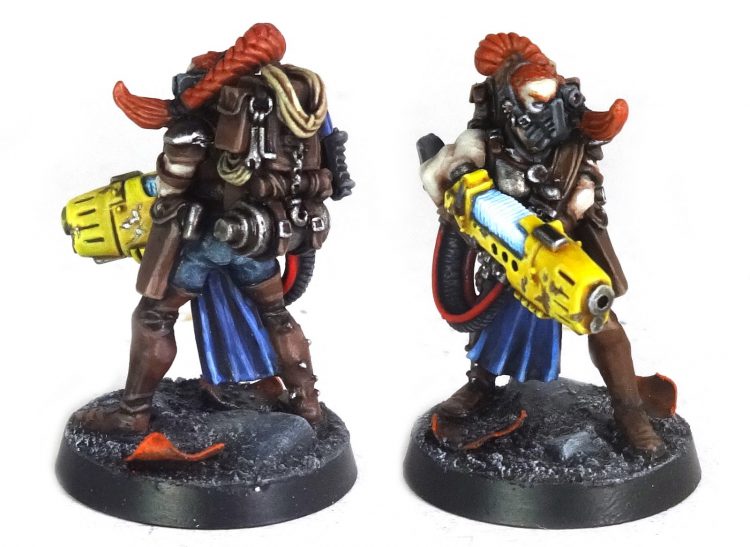
What are the Strongest Spammable Weapons?
Our initial recommendation here is that an Arbitrator should, if necessary, have a conversation with their players about spam and whether it’s in the spirit of Necromunda. I have a bias here, I never take the same loadout on two fighters in my gang. It’s one of my personal rules. While there are many weapon imbalances in Necromunda, that kind of guideline stops it being a real problem for campaigns – yes, your Delaque player’s web gun Phantom with the Infiltrate skill is terrifying, but there’s only one of him, he’ll shoot his shot and the rest of the game may go differently. The imbalances show more, and may cause some negative play experiences, when an entire gang is rocking some clearly-underpriced weapon. Some potential problem weapons:
- Plasma Guns can be a stand-out weapon, especially at the outset. They’re just a very reasonable price for their output, and the rare +2 to-hit bonus within 12” can be very unnerving to new players. Especially if they came from a background of classic Necromunda, players don’t like to be in full cover and be told they’re still hit on a 2+! To some extent that problem solves itself as everyone learns the game. Plasma Gun spam only tends to be a huge problem if you play on open boards, where people get the idea that ‘shooting is king’ in Necromunda, and the tuned stats make it better.
- Boltguns, and even more Enforcer Boltguns, are just great weapons for the price. If your House gangs are giving a Boltgun to every fighter that can’t take a special weapon, you may want to keep an eye on the effects. As with Plasma Guns, access to these weapons can further strengthen gangs that are already excelling at the shooting game.
- Cawdor Blunderpoles are just the most insanely efficient templates. Our own Goonhammer advice to Cawdor players has been ‘take all of them’. However, if your other players aren’t taking a similarly optimised approach, maybe dissuade your own religious fanatics from this approach.
- The Blast targeting rules in Necromunda are extremely powerful, making most (not all) blast template weapons strong buys. Basically, in addition to the obvious and intended benefits of affecting multiple enemy fighters, you target a point on the board rather than an enemy fighter, which lets you both ignore the BS penalties for cover, and shoot at some models who are hidden in total cover, e.g. standing just around a corner. This is not a gang-specific balance issue as all gangs can access Blast weapons. Some gangs, such as Goliaths or Enforcers, could lean further into their Blast choices at Gang Creation, but it’s open to all. Our main advice here is to make sure that all your players understand how these weapons work. Your group may want to implement house rules, for example, I’ve heard some suggest that if you target a point in order to hit models in Full Cover, or completely hidden, you still take a -2 to BS. But the real negative play experience to avoid is when a new or casual player moves their models, thinking they are entirely or mostly safe from shooting, and then gets sniped around corners in what they see as a very gamey move. Just knowing what to expect will mitigate that.
- Corpse Grinder melee weapons are by far the most efficient in the game. This doesn’t particularly contribute to Corpse Grinders winning games – you expect elite pure-melee fighters to mince the opposition on a Charge action – but with high attacks, Damage and the Sever rule a Corpse Grinder player can inflict so many lasting injuries on their victims that death or severe stat decreases are the most likely outcome. Personally my group plays it that no matter how many Out of Action results are suffered, a removed fighter only ever takes one Lasting Injury roll. Some people prefer to play it by the book, but consider that this may lead to some negative play experiences if you have a Corpse Grinder player. On a wider level, the Corpse Grinders’ themed melee weapons outshine all others and are available from the Trading Post. If your group is competitively minded, consider adjusting this somehow, as 15 credit fighting knives, 20 credit flails and 25 credit chainswords, basically all the variety of thematic mid-to-budget Necromunda melee weapons, cannot compete with the ubiquitous 20 credit Boning Sword.
Some Equipment Plays Rock, Paper, Scissors
There is a definite theme running through equipment of wargear which is designed to defend against certain weapons. This is an interesting one as such tailored upgrades aren’t usually good value in a theoretical discussion. But if you know exactly who you’re facing, e.g. in small groups for a specific campaign, they can lead to a rock/paper/scissors effect which some players may not enjoy. Respirators give you a significant boost against Gas weapons, but they don’t nullify them completely, and they’re 15 credits each. Hazard Suits stop Blaze, which is very nice, but is it worth giving up the better armour save of Mesh Armour? These are more on the minor end and most competitive players won’t be leaning too hard on such match-ups. There are a few types of match-up which may have a more pronounced effect:
- Smoke Grenades require some player skill (and luck) to use, but are negated by Photo-goggles and Infra-sights. The former are a lot less expensive and one fighter can cover multiple allies with smoke; on the other hand, Photo-goggles and Infra-sights work automatically and do have other benefits. We don’t think this needs much house-ruling, just be sure all your players are aware the mechanic exists and how it works going into a campaign. I’ve seen some players get a bit annoyed at careful smoke grenade usage completely nullifying their shooting (which was their entire game plan).
- Reflec Shrouds are 30 credits, and are Mesh Armour but all las, plasma and melta weapons have AP- against the wearer. If you are playing against Van Saar or any other gang which has invested heavily in these weapons, it’s the best armour in the game. RAW your total save is unaffected, so you would still get the bonus for Armoured Undersuits, Corpse Grinder Masks etc. Not only is this a pretty damn good piece of kit full stop, it is a real potential fun-ruiner for gangs which have invested in heavy duty energy weapons. Maybe control this to prevent mass-equipping a gang with it, or house rule it as an unalterable 5+ save against such weapons.
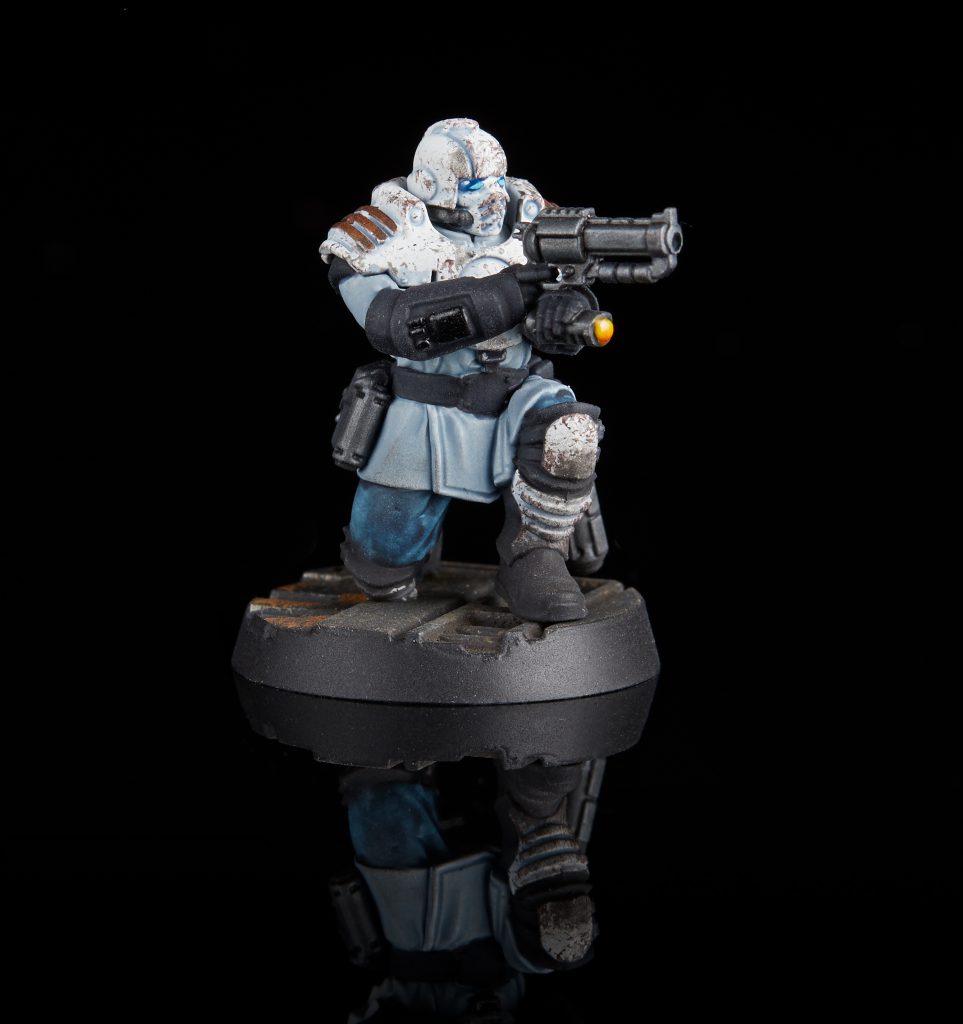
Some Equipment is just Bonkers
The Book of Judgment is a real culprit here. There is some bonkers stuff in the Trading Post section there. As a general rule, consider a ‘one per gang’ rule for a lot of the super esoteric equipment. The book introduces some really cool, RPG style equipment for gangs, but the best items are very open to abuse. Some particular problem children:
- Falsehoods. These suckers make getting into melee combat child’s play. As we’ve mentioned in previous articles, melee is far more decisive than shooting in Necromunda thanks to coup de grace mechanics. So making it easy to get there is sort of screwing with the fundamentals of the game.
- Ablative Overlays. A +2 to your armour save, but it degrades with use. That sounds OK on paper, but really, most Necromunda games will be decided in a couple crucial exchanges as fighters face off. These things are way too good compared to other armours, and when used en masse they introduce a lot of finicky book-keeping into the game keeping track of whether each fighter has used theirs up. We would certainly recommend some sort of balance change here, raising cost, making them one-use-only (i.e. deleted from the Gang Roster after one game) or simply banned.
- Frenzon Collars. Chems are a cool concept, they have great benefits but are one-use and can cause addiction. Frenzon Collars ignore that, you get a constant, powerful drug effect with an added group-activation ability. No repeat payments, minimal drawbacks.
- Cameleoline Cloaks. -2 to be hit at range unless you moved in your last activation. This is a very significant boost to any fighter, but especially those who want to plug away at range. Careful play against them can minimise the benefits, but an entire fire support section of a gang using these would just be obnoxious.
Wrapping Things Up
As mentioned at the start, there’s not necessarily any need to sit down and thrash out every balance issue in Necromunda before beginning a campaign. You’d go mad and spend weeks doing this before you could start playing games! Firstly, does your group need or want this kind of pro-active approach? Some players like to be assured everything is fair before they start, and some prefer to play ‘by the book’ unless it’s manifestly unfair. A few players want to win, and/or want to use all the best toys available to them, and damn the consequences. If your group all fit into one category, then it’s all good. If they’re a mix you want to either get everyone on the same page, or sort out a method that’s agreeable to everyone.
If you think we’ve missed anything off the list of potential imbalances/mismatches, you’ve had vastly different campaign experiences, or you want to tell us we’re dead wrong and a bunch of scavvy scummers, then feel free to write in! You can drop us a note in the comments below or email us at contact@goonhammer.com.
